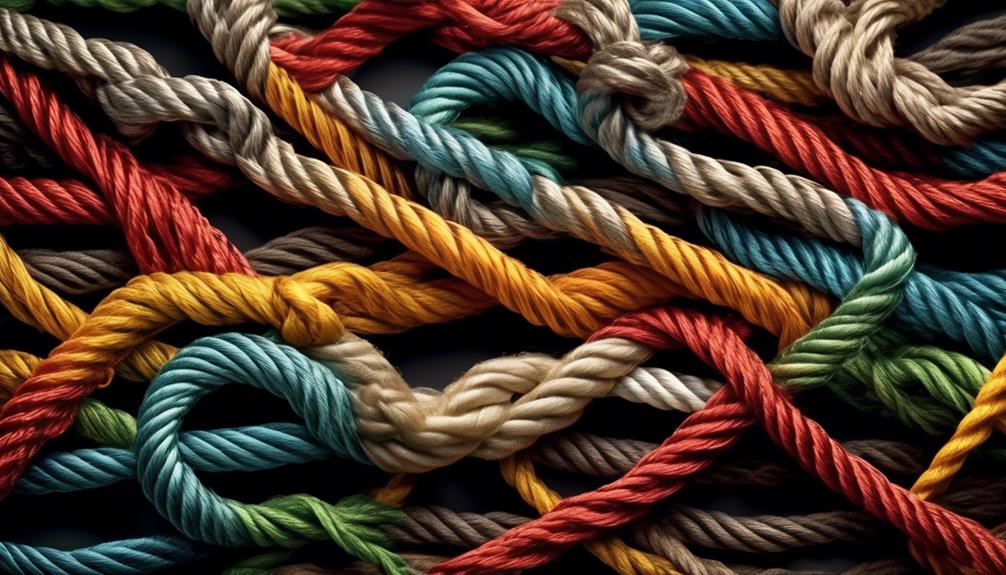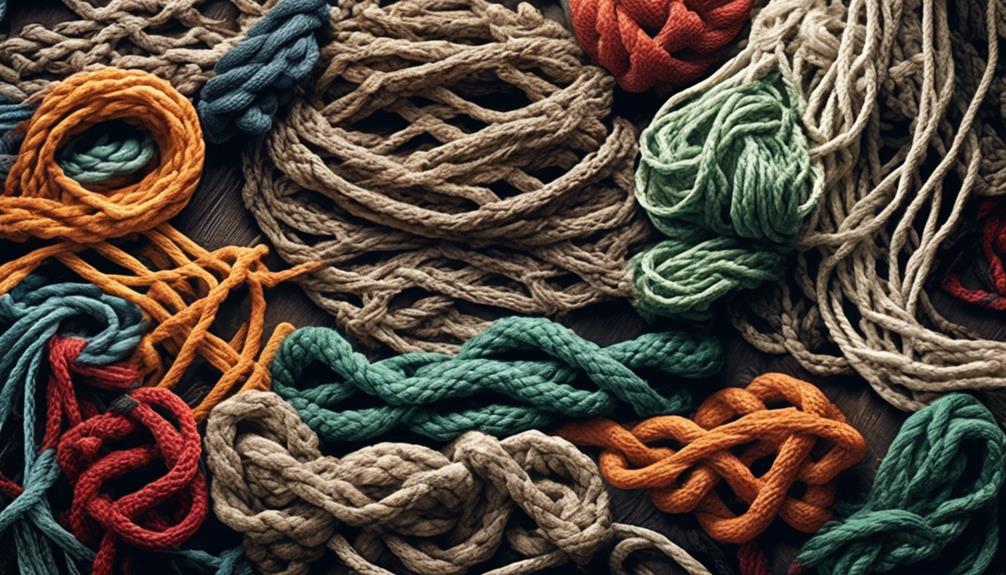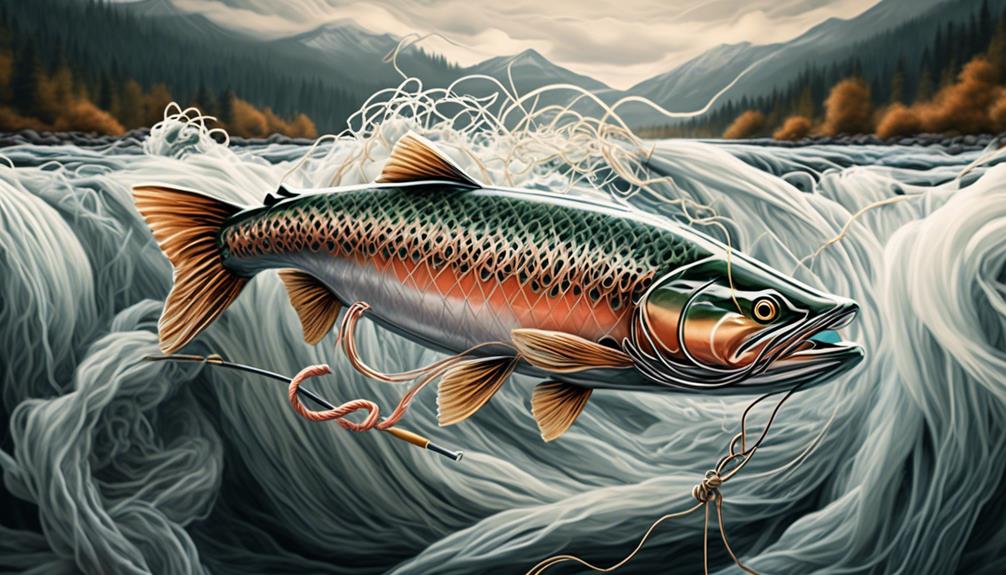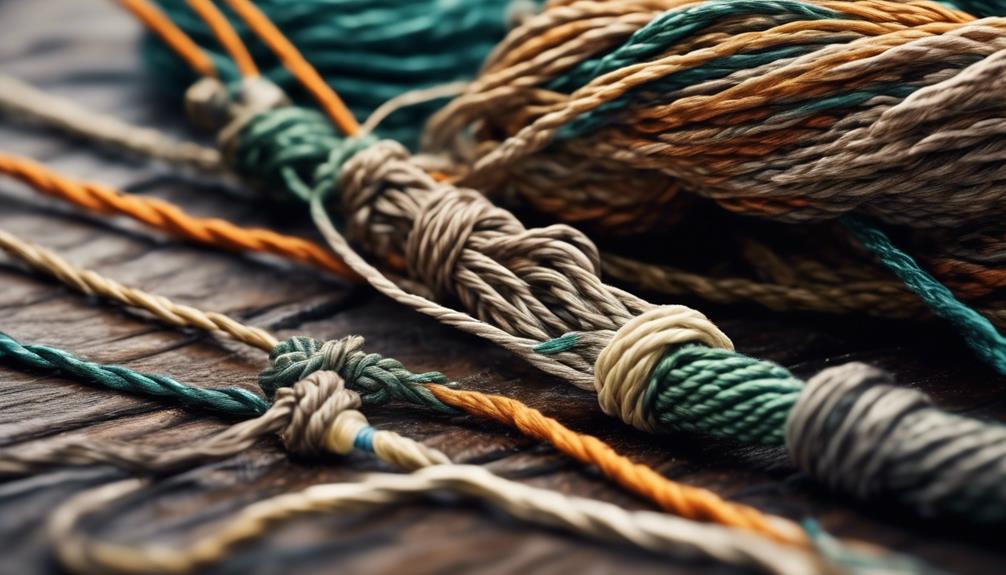So, you've got your fishing rod, your bait, and your tackle box all set up, ready to catch the big one.
But hold on a second – have you given much thought to the knots you'll be tying? Sure, it's not the most glamorous part of fishing, but it's absolutely crucial.
Whether you're a seasoned angler or just starting out, understanding the right fishing knots can make all the difference between a successful catch and a missed opportunity.
Stick around to discover 13 varied types of fishing knots that will take your angling game to the next level.
The Importance of Fishing Knots
Understanding the importance of fishing knots is crucial for every angler to ensure a successful and secure fishing experience. When you're out on the water, the last thing you want to worry about is whether your knot will hold or if it will fail when you hook a big fish. The importance of knot strength can't be overstated. A strong knot can mean the difference between landing that trophy fish or watching it swim away with your bait and tackle.
Proper knot tying techniques are essential for maintaining knot strength. Learning how to tie knots correctly ensures that the line maintains its full strength, giving you the confidence to tackle even the most challenging catches.
As an angler, you need to be aware of the various forces that act on your fishing line when you're out on the water. Factors such as the size and strength of the fish, the type of fishing line, and even the water conditions can all affect the integrity of your knots. By understanding the importance of knot strength, you can choose the right knot for the job and tie it in a way that maximizes its holding power.
Proper knot tying techniques involve attention to detail and practice. Take the time to learn and master the knots that are best suited for the type of fishing you do. Understanding the importance of knot strength and proper knot tying techniques will give you the confidence to tackle any fishing situation with ease.
Basic Fishing Knots
You can start mastering basic fishing knots by learning the improved clinch knot. This knot is a fundamental and widely used technique for securing the fishing line to the hook. To tie the improved clinch knot, thread the line through the eye of the hook and double back parallel to the standing line. Then, make five to seven wraps around the line before threading the loose end through the loop near the eye of the hook. Finally, moisten the knot and pull it tight to complete the process.
Mastering this knot tying technique is essential for ensuring fishing knot strength and preventing the hook from coming loose when reeling in a catch.
Another basic fishing knot worth mastering is the Palomar knot, known for its simplicity and high strength. To tie the Palomar knot, double the line and pass it through the eye of the hook. Then, tie a simple overhand knot, leaving the hook attached to the loop. Finally, pull the loop down, moisten the knot, and pull both ends of the line to tighten. This knot is renowned for its reliability and can be used with braided or monofilament fishing lines.
Understanding these basic fishing knot tying techniques and their impact on fishing knot strength is crucial for any angler looking to improve their skills and success on the water.
Advanced Fishing Knots
When mastering advanced fishing knots, the knot known as the double uni knot is a versatile and reliable choice for connecting two lines together. This knot is particularly useful when joining lines of different materials or diameters.
To tie the double uni knot, follow these steps:
- Form a Loop: Overlap the ends of the two lines you want to join, creating a loop with the tag ends.
- Wrap the Lines: Take the tag end of the first line and wrap it around the second line and through the loop 3-4 times. Then, do the same with the tag end of the second line, wrapping it around the first line and through the loop 3-4 times as well.
- Moisten and Pull: Moisten the knot and pull the standing lines in opposite directions to slide the wraps together. Finally, trim the tag ends.
In addition to the double uni knot, advanced knot tying techniques also include the Bimini twist and the Alberto knot. The Bimini twist creates a strong loop at the end of a line, often used for offshore fishing and connecting a double line to a leader.
On the other hand, the Alberto knot is ideal for joining lines of unequal diameters or different materials. These intricate knot variations require precision and practice to master, but they offer enhanced strength and reliability in challenging fishing situations.
Essential Fishing Knots for Beginners
As a beginner, mastering essential fishing knots is crucial for your success and enjoyment on the water. Learning the right knot tying techniques and using the appropriate knot tying tools will significantly enhance your fishing experience.
To start, the improved clinch knot is essential for securing your hook to the fishing line. It's relatively easy to tie and provides good strength.
Another fundamental knot is the Palomar knot, which is perfect for tying hooks or lures to your line. Its simplicity and strength make it an ideal choice for beginners.
When it comes to knot tying techniques, practice is key. Take the time to familiarize yourself with each knot and practice tying them at home before heading out to the water. Understanding how to tie each knot properly will give you confidence and peace of mind while fishing.
Additionally, having the right knot tying tools, such as a pair of nail clippers or line snips, will make the process much easier. These tools allow you to trim the excess line after tying your knots, ensuring a neat and secure finish.
Specialized Fishing Knots for Different Situations
Mastering essential fishing knots as a beginner sets the foundation for your success, and as you progress, you'll find that specialized fishing knots cater to different situations and techniques, enhancing your versatility as an angler.
When it comes to specialized fishing knots, it's essential to consider the different materials you'll be working with and the specific techniques you'll be employing. Here are some specialized fishing knots designed for different situations:
- Knots for Braided Lines
- The Palomar knot is particularly effective for braided lines due to its ability to maintain a high level of strength and reliability. This knot is relatively easy to tie, making it a practical choice for anglers using braided lines.
- The Double Uni Knot is another excellent option for joining braided lines. It provides a strong and smooth connection, which is important when dealing with the unique properties of braided lines.
- Knots for Specific Techniques
- When finesse fishing with fluorocarbon lines, the Double Palomar knot excels. It offers enhanced knot strength, crucial for finesse techniques that require precision and delicacy.
- For topwater fishing where the knot's impact on lure action is critical, the Loop knot is a go-to choice. It allows the lure to move more freely, creating a more natural presentation to entice fish in specific situations.
Knots for Different Fishing Lines
Braided, monofilament, and fluorocarbon lines each require specific knots to ensure optimal strength and performance while fishing.
When it comes to the best knots for braided lines, the Palomar knot is a popular choice. It's relatively easy to tie and offers excellent strength, making it well-suited for braided lines.
To tie the Palomar knot, double about 6 inches of the line and pass it through the eye of the hook. Then, tie an overhand knot with the doubled line, leaving a loop large enough to pass the hook through. After moistening the knot, pull both ends of the line to tighten it against the eye of the hook.
For monofilament lines, the improved clinch knot is highly recommended. It's a reliable and simple knot that maintains good strength and is easy to tie even in low light conditions.
To tie the improved clinch knot, thread the line through the eye of the hook and make 5 to 7 wraps around the line. Then, pass the end of the line through the loop near the eye of the hook and the larger loop. Finally, moisten the knot and pull both the tag end and the standing line to tighten it.
Fluorocarbon lines work well with the double uni knot, which provides strong and reliable performance. This knot is particularly useful for tying fluorocarbon lines to leaders or joining lines of different diameters.
To tie the double uni knot, overlap the ends of the lines to be joined and form a loop. Take the tag end and make 4 turns around both lines and through the loop. Then, moisten the knot and pull the tag end and standing lines to tighten it, before trimming the tag ends.
Knots for Specific Fishing Techniques
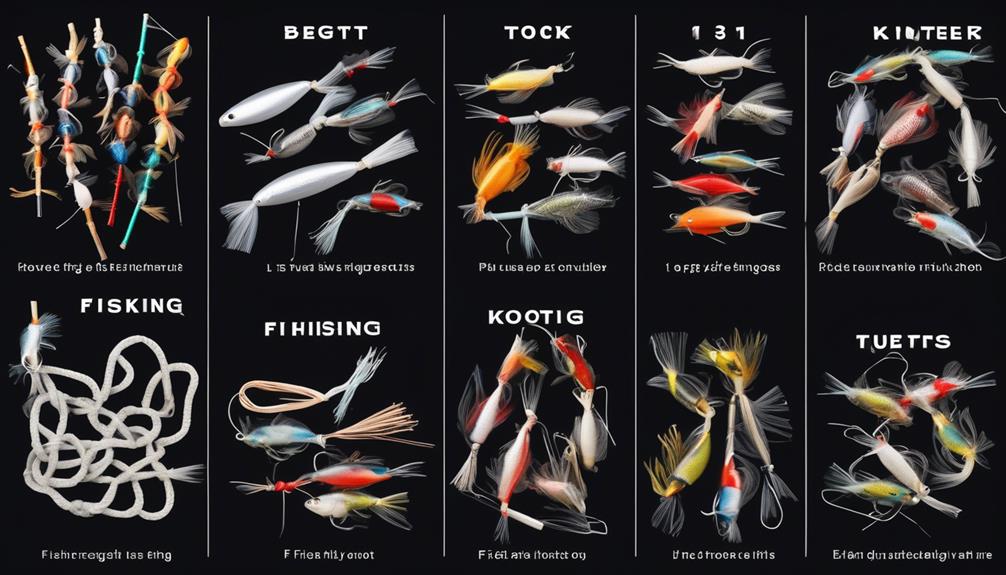
When targeting specific fish species, mastering the appropriate knots for techniques such as drop shotting, Carolina rigging, and topwater fishing becomes essential for maximizing your chances of success. Different fishing techniques require specific knots tailored to their unique requirements. Here are some key knots for specific fishing techniques:
- Knots for Fly Fishing
- *Improved Clinch Knot*: This knot is ideal for securing a fly to the leader. Its strength and reliability make it a popular choice among fly anglers.
- *Non-Slip Loop Knot*: A crucial knot for attaching a fly to the tippet, allowing for better movement and presentation of the fly to entice fish.
- Tying Knots for Saltwater Fishing
- *Palomar Knot*: Known for its strength, the Palomar knot is well-suited for saltwater fishing, particularly when using braided lines. It's highly reliable and maintains a high percentage of the line's original strength.
- *Uni Knot*: This versatile knot is effective for a variety of saltwater fishing applications, including attaching terminal tackle, securing swivels, and connecting hooks.
Mastering these knots for specific fishing techniques equips you with the necessary tools to tackle diverse fishing scenarios effectively. Whether you're fly fishing for trout in a river or pursuing saltwater game fish in the open ocean, having a solid grasp of these knots will enhance your angling experience and increase your chances of landing that prized catch.
Pro Tips for Tying Fishing Knots
To improve your knot tying skills, focus on practicing with different types of fishing lines and varying tension levels to achieve optimal knot strength and reliability. When tying fishing knots, improving knot strength is crucial for ensuring that your line stays secure when reeling in a catch. One pro tip for enhancing knot strength is to lubricate the knot with water or saliva before tightening it. This reduces friction and heat, allowing the knot to cinch smoothly and maintain its strength.
Another essential aspect of tying fishing knots is avoiding common mistakes. One prevalent mistake isn't properly seating the knot against the eye of the hook or lure. This can weaken the knot and lead to slippage or breakage when under pressure. To prevent this, ensure that the knot is snug and seated tightly against the eye of the hook or lure before final tightening.
Moreover, it's important to pay attention to the type of knot being used for different fishing scenarios. Some knots are better suited for specific line types or fishing techniques. For example, the Palomar knot is known for its strength and is suitable for braided lines, while the improved clinch knot is commonly used with monofilament lines.
Frequently Asked Questions
What Are the Best Types of Fishing Knots for Securing Lures or Bait?
For securing lures or bait, the best types of fishing knots for beginners are the improved clinch knot and the palomar knot.
Advanced anglers often prefer the FG knot or the uni knot for their strength and reliability.
Popular fishing knots like the improved clinch knot are easy to tie but may slip with braided lines.
The palomar knot is strong and easy to tie, but it may not work well with larger diameter lines.
How Do Different Weather Conditions Affect the Strength and Reliability of Fishing Knots?
Different weather conditions can impact knot strength and reliability. Factors like wind, rain, and temperature can weaken knots, affecting their ability to hold under pressure.
For instance, strong winds can make it more challenging to tie secure knots, while rain can cause the line to become slippery, reducing the knot's reliability.
Understanding how weather affects knots is crucial for ensuring successful fishing experiences in various conditions.
Are There Any Fishing Knot Techniques Specifically Designed for Catching Larger Fish?
When targeting larger fish, it's essential to focus on fishing knot strength and specific techniques. Strong knots like the Palomar and Improved Clinch are great for handling the force of big catches.
Additionally, techniques such as the Bimini Twist or the Albright Special can provide added security when dealing with larger fish.
Can Fishing Knots Be Used for Purposes Other Than Securing Fishing Line, Such as Repairing Equipment or Creating Makeshift Tools?
Yes, fishing knots can be incredibly versatile for repairing gear and making tools. They can be used to mend broken straps, secure items together, or even fashion makeshift handles.
The strength and reliability of fishing knots make them useful beyond just securing fishing line. When in a pinch, you can rely on these knots to help with various tasks, from repairing equipment to creating makeshift tools in the great outdoors.
Are There Any Cultural or Historical Significance Behind Certain Types of Fishing Knots?
Certain types of fishing knots hold cultural significance and have historical origins. These knots often carry symbolism and are tied using traditional fishing techniques passed down through generations.
For many communities, these knots represent a connection to their heritage and are integral to their fishing practices. Understanding the cultural and historical aspects of these knots adds depth to the art of fishing and fosters a deeper appreciation for traditional methods.
Conclusion
Now that you have explored 13 varied types of fishing knots, you can see the importance of choosing the right knot for different fishing situations.
Whether you're a beginner or an advanced angler, having a solid understanding of fishing knots is essential for success on the water.
Keep practicing and refining your knot-tying skills, and don't be afraid to experiment with different knots to see what works best for you.
Happy fishing!
